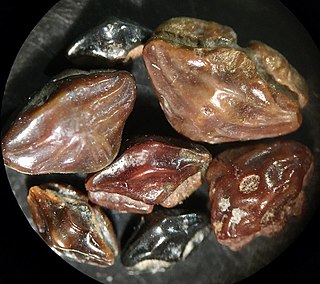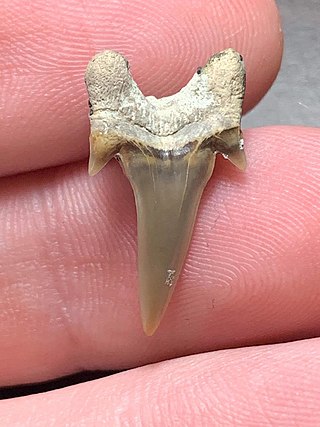
Rajiformes is one of the four orders in the clade Batomorphi, often referred to as the superorder Batoidea, flattened cartilaginous fishes related to sharks. Rajiforms are distinguished by the presence of greatly enlarged pectoral fins, which reach as far forward as the sides of the head, with a generally flattened body. The undulatory pectoral fin motion diagnostic to this taxon is known as rajiform locomotion. The eyes and spiracles are located on the upper surface of the head and the gill slits are on the underside of the body. Most species give birth to live young, although some lay eggs enclosed in a horny capsule.

Edaphodon was a fish genus of the family Callorhinchidae. As a member of the Chimaeriformes, Edaphodon was a type of rabbitfish, a cartilaginous fish related to sharks and rays. The genus appeared in the Aptian age of the Lower Cretaceous and vanished in the Pliocene. It was most prominent during the Late Cretaceous. Many Edaphodon species were found in the Northern Hemisphere, but species from the Southern Hemisphere are also known.

Schizorhiza is an extinct genus of schizorhizid sclerorhynchoid that lived during the Late Cretaceous. It contains one valid species, Schizorhiza stromeri. It lived from the Campanian to Maastrichtian, and its fossils have been found in Africa, the Middle East, North America, and South America.
Paleontology or palaeontology is the study of prehistoric life forms on Earth through the examination of plant and animal fossils. This includes the study of body fossils, tracks (ichnites), burrows, cast-off parts, fossilised feces (coprolites), palynomorphs and chemical residues. Because humans have encountered fossils for millennia, paleontology has a long history both before and after becoming formalized as a science. This article records significant discoveries and events related to paleontology that occurred or were published in the year 1994.

Ischyrhiza is an extinct genus of sclerorhynchoid ray from the Late Cretaceous (Cenomanian-Maastrichtian).

Hybodontiformes, commonly called hybodonts, are an extinct group of shark-like cartilaginous fish (chondrichthyans) which existed from the late Devonian to the Late Cretaceous. Hybodonts share a close common ancestry with modern sharks and rays (Neoselachii) as part of the clade Euselachii. They are distinguished from other chondrichthyans by their distinctive fin spines and cephalic spines present on the heads of males. An ecologically diverse group, they were abundant in marine and freshwater environments during the late Paleozoic and early Mesozoic, but were rare in open marine environments by the end of the Jurassic, having been largely replaced by modern sharks, though they were still common in freshwater and marginal marine habitats. They survived until the end of the Cretaceous, before going extinct.
The Toolebuc Formation is a geological formation that extends from Queensland across South Australia and the Northern Territory in Australia, whose strata date back to the Albian stage of the Early Cretaceous. Dinosaurs, pterosaurs, plesiosaurs, ichthyosaurs, protostegid turtles, sharks, chimaeroids and bony fish remains are among the fossils that have been recovered from the formation.

Onchopristis is an extinct genus of sclerorhynchoid from the Cretaceous of North Africa, Europe, and North America. Its name is derived from the Ancient Greek ónkos and prístis. It contains two valid species, O. numida and O. dunklei, though some researchers argue that both may be considered a single taxon with variation in morphology caused by a wide geographical range. Specimens of Onchopristis have been discovered in coastal and fluvial deposits dated from the Barremian to the Maastrichtian age, making this genus one of the oldest and longest-lived sclerorhynchoid genera.
This list of fossil fish species is a list of taxa of fish that have been described during the year 2012. The list only includes taxa at the level of genus or species.
This list of fossil fishes described in 2014 is a list of new taxa of placoderms, fossil cartilaginous fishes and bony fishess of every kind that have been described during the year 2014, as well as other significant discoveries and events related to paleontology of fishes that occurred in the year 2014. The list only includes taxa at the level of genus or species.

Megalocoelacanthus dobiei is an extinct species of giant latimeriid coelacanth lobe-finned fish which lived during the Lower Campanian epoch until possibly the early Maastrichtian in the Late Cretaceous period in Appalachia, the Western Interior Seaway and Mississippi Embayment. Its disarticulated remains have been recovered from the Eutaw Formation, Mooreville Chalk Formation, and Blufftown Formation of Alabama, Mississippi, and Georgia, and also from the Niobrara Formation of Kansas. Although no complete skeleton is known, careful examination of skeletal elements demonstrate it is closely related to the Jurassic-aged coelacanthid Libys. The species is named for herpetologist James L. Dobie. It has been estimated to have been 3.5–4.5 metres (11–15 ft) in length.

Ptychotrygon is a genus of sawfish-like ray whose fossils have been found worldwide from the Cretaceous period (Albian-Maastrichtian). Along with Ptychotrygonoides, Texatrygon, and Asflapristis, it is the member of the family Ptychotrygonidae within the suborder Sclerorhynchoidei.

Sclerorhynchoidei is an extinct suborder of rajiform rays that had long rostra with large denticles similar to sawfishes and sawsharks. This feature was convergently evolved, recently proposed as 'pristification', and their closest living relatives are actually skates. While they are often called "sawfishes", sawskates is a more accurate common name proposed in 2021 for sclerorhynchoids, which has been subsequently used by other researchers.
Ptychotrygonidae is an extinct family of cartilaginous fish from the Cretaceous period belonging to the suborder Sclerorhynchoidei. This family contains the genera Archingeayia, Asflapristis, Ptychotrygon, Ptychotrygonoides, and Texatrygon.
The Bladen Formation is a geologic formation from the Late Cretaceous of North Carolina and South Carolina, USA. It is known for a plethora of terrestrial and aquatic vertebrate fossils, including dinosaurs and mosasaurs. It appears to be roughly concurrent with the Tuscaloosa Formation of Alabama.

Archaeolamna is an extinct genus of mackerel sharks that lived during the Cretaceous. It contains three valid species which have been found in Europe, North America, and Australia. While it is mostly known from isolated teeth, an associated set of teeth, jaws, cranial fragments, and vertebrae of A. kopingensis is known from the Pierre Shale of Kansas. Teeth of A. k. judithensis were found with a plesiosaur skeleton with bite marks from the Judith River Formation of Montana. It was a medium-sized shark with an estimated total body length of 3–4 metres (9.8–13.1 ft).
This list of fossil fish research presented in 2023 is a list of new fossil taxa of jawless vertebrates, placoderms, cartilaginous fishes, bony fishes, and other fishes that were described during the year, as well as other significant discoveries and events related to paleoichthyology that occurred in 2023.

The Akrabou Formation is a Late Cretaceous -aged geological formation and Konservat-Lagerstätte in Morocco. It overlies the slightly older freshwater deposits of the Kem Kem Group, which it was once thought to be apart of. It was deposited over following the Kem Kem ecosystem's submergence by the Tethys Ocean during a marine transgression from the Cenomanian-Turonian boundary event, as part of a wider deposition of carbonate platforms across the region from the event.










